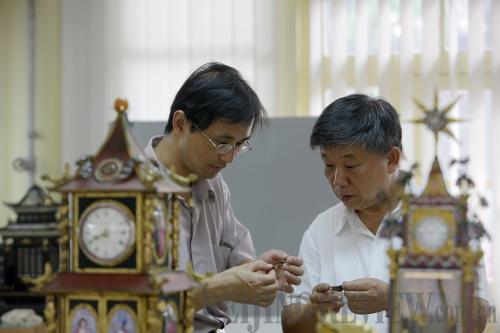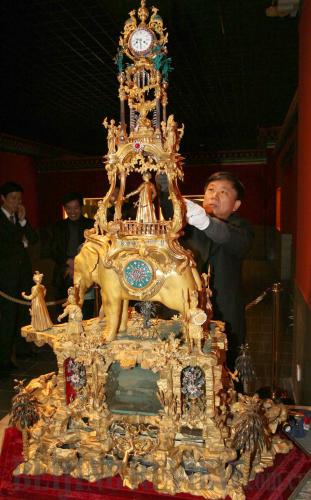|
 |
|
LEARNING SKILLS: Chen Donghe (left) from Taipei palace museum learns to conserve imperial clocks with Qin Shiming, a clock conservator at Beijing's Palace Museum (XING GUANGLI) |
For the first time in 60 years, relics from Qing Dynasty (1644-1911) Emperor Yongzheng (1678-1735) that have been stored separately at the palace museums in Beijing and Taipei have been brought together in an exhibition that opened on October 7 at the Taipei museum, known as the "National Palace Museum."
The exhibition, named Harmony and Integrity: The Yongzheng Emperor and His Time, will last until January 10, 2010.
"The exhibition is a landmark indicator of the exchanges launched by the two museums more than half a year ago," said Zheng Xinmiao, Curator of the Palace Museum in Beijing's Forbidden City.
With cooperation gradually improving between experts from the two museums across the Taiwan Straits, there have been more opportunities to jointly research their relics.
In July, Chen Donghe, a Taipei palace museum researcher in mechanical engineering, materials science and cultural relic's preservation, came to the Palace Museum in Beijing with two research topics—testing ancient ceramics and researching restoration techniques for clocks and watches.
"I am very lucky to be the first staff member from the Taipei museum who has been granted a permit to enter restricted work areas at Beijing's museum," Chen said. He has been issued a magnetic security card, allowing him to enter any restricted conservation laboratories in Beijing's museum.
 |
|
COLORFUL TIME: Clock conservator Qin Shiming introduces a gold-plated imperial clock from Beijing's Palace Museum (REN LONG) | In March, the two museums' curators began the first exchange visits in 60 years and launched a researcher exchange system. Under the system, the two palace museums will send one or two researchers every year to the other institution.
Chen said his two research topics involve burning questions at Taipei's museum, while Beijing has already accumulated a body of knowledge on the subjects.
Situated in the heart of Beijing, the Forbidden City is the imperial palace of two consecutive dynasties—the Ming and Qing dynasties. A total of 24 emperors lived in the palace, the construction of which was completed in 1420. Covering an area of 72 hectares, the Forbidden City has 9,999.5 rooms and is called a "sea of regal buildings." It is now the largest and most complete imperial palace and ancient building complex in China and the world.
Numerous precious cultural relics collected by the royal families were kept there. However, since the 1930s and 1940s, many of the valuable paintings, calligraphic works, ceramics and decorative objects of the Forbidden City were moved out of the palace and eventually transferred to Taiwan, where they remain to this day, creating a situation of one imperial palace, with two palace museums.
Although the collections of the two museums have their own unique characteristics and strengths, neither of them is complete. Only combined as a whole can the two museums present to visitors a complete view of the best ancient Chinese artworks and artifacts, and a thorough understanding of the best elements of Chinese culture.
| 